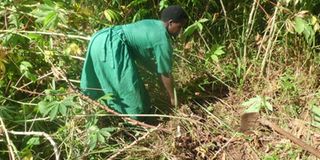Cassava brown streak virus poses challenge as varieties succumb

A farmer uproots diseased cassava from her garden. Photo | Lominda Afedraru | File
Across Africa, cassava is vulnerable to a broad range of diseases as well as less known viral strains across tropical cassava-growing regions.
In Uganda, the most common are Cassava Brown Streak Virus (CBSV), which leads to root rot, and Cassava Mosaic Virus (CMV), which shows in yellowing and wrinkled leaves.
Dr Titus Alicai, from the National Crop Resources Research Institute (NaCRRI), reveals that in East Africa CBSV was reported in Tanzania in 1936, followed by Kenya in 1950 and in Uganda in 2004.
It is caused by the whitefly, which usually rests on the undersurface of the leaves where it lays eggs which end up destroying the leaves by turning them yellow.
The disease, which has not been common in northern Uganda, is now being spotted in many fields.
A case in point is farmers in Kole District, where incidence was confirmed by scientists from Ngetta Zonal Agricultural Research and Development Institute (Nzardi). However, the district’s assistant agricultural officer gave a different view.
Outcry
Cassava is a staple food and cash crop in Lango region. The farmers have been growing a local variety, Bao, with no infestations arising from CBSV. But it is also succumbing to the virus.
However, the improved cassava variety, supplied in 2006 under the Naads, succumbs to the disease.
There is a general outcry because the common cassava virus cited was mainly CMV but farmers in Kole District realised that CBSV was ravaging their fields.
“It had already affected the cassava in my two acres. When I tried to uproot it, I saw some brown and black spots. We call it ‘tuo mogo’ meaning cassava disease,” says Bernard Agil, a farmer.
He used to earn about Shs550,000 in a season from cassava which is no longer the case.
Farmers are abandoning the “Naads” variety for the traditional variety, which takes one and a half years to mature yet the improved variety takes eight months.
But Geoffrey Oloro, Kole District agricultural officer, gives a contrary view that the traditional variety farmers are referring to called Okello Otiti was given to them under Naads. It has since succumbed to the virus.
Better varieties
Farmers are now advised to grow Nase 14 variety developed at Namulonge. His department usually purchases clean plantlets from Nzardi, which is given out to farmers free of charge.
“We usually go out to sensitise farmers on how to manage the disease but many of them do not follow the good agronomy practice,” he explains.
Dr Alfred Komakech, a cassava breeder, Nzardi, says “We have a programme of training extension workers how they could sensitise farmers about handling the disease. We told them to emphasise the issue of quarantining infected cassava plants on farms.”
CBSV has been faced by farmers in central Uganda due to influx of white flies but in Northern Uganda it is not yet that grave.
So he encourages farmers to grow Nase 14, which Nzardi multiplies and supplies to farmers under Eastern Africa Agricultural Productivity Programme.




